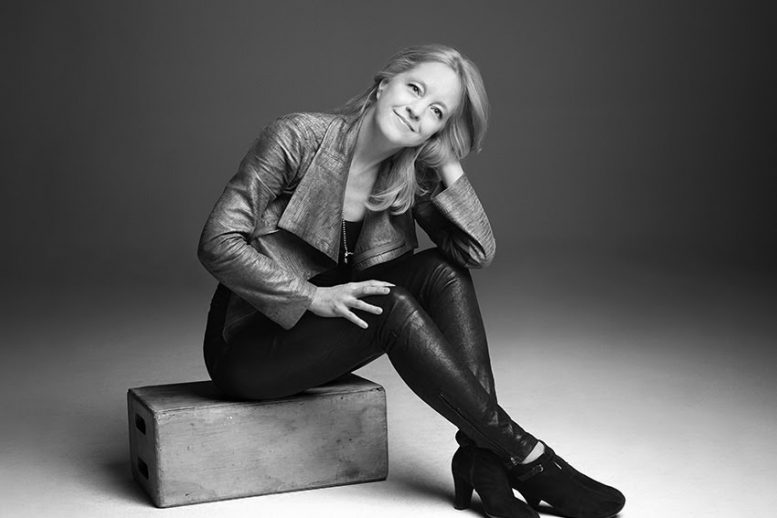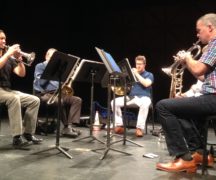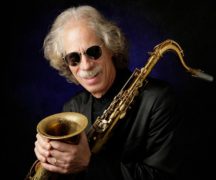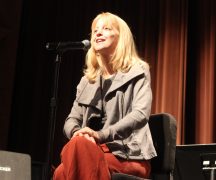By DAVID DUPONT
BG Independent News
Maria Schneider has high standards for the members of the Maria Schneider Orchestra.
They represent the best players on the New York jazz scene, and some of them have been with her since she launched the ensemble more than 25 years ago.
When she visits colleges and universities, she expects top quality performances as well. “I never approach anything like this with anything but the highest expectations of what the music can convey,” the composer said in a recent telephone interview.
Schneider, who has won Grammy Awards in jazz, classical for her collaboration with soprano Dawn Upshaw, and pop for her work with David Bowie, will visit Bowling Green State University for Jazz Week as the Hansen Musical Arts Series artist. Her three-day visit will culminate with a free concert Friday, March 30, at 8 p.m. in Kobacker Hall when the Jazz Lab Band I, directed by David Bixler, will play of program of Schneider’s music. She will also present master classes, participate in a question-and-answer session, and discuss digital rights for music during her stay, which begins Wednesday, March 28. Click here for more details. http://bgindependentmedia.org/composer-maria-schneider-bgsu-jazz-week-guest-artist/.
She said she always coordinates with the college band’s director to get a sense of the ensemble’s strengths and weaknesses, and the soloists who will be featured. Sometimes she’s working with a band at a liberal arts school where, unlike at BGSU, few of the band members are music majors. “You just work with what you have and the make the best of it. It’s really fun,” Schneider said.
“When I work with students, I push them the way I would push my group or a professional group,” Schneider said. “I push them to get the best possible result. The power of music doesn’t always depend on perfection. You want the intonation, and you want all those details.
“I’ve had performances of my music with young groups where everybody had the right intent. They knew the sound they were going for. The emotion came through the music so it made the hair on my arms stand up,” she said. “Music has this magic that comes through when the intent is there, when the right elements are there. That’s the mystery of it. I never approach anything like this with anything but the highest expectations of what the music can convey.”
That music can speak volumes, even at its most delicate moments.
While she employs the standard instrumentation of a jazz big band, she works to subvert those expectations. “That’s why I call my own group an ‘orchestra.’ I didn’t want people to have any preconceived ideas about the big band idiom.”
The instrumentation still holds a world of possibilities for her. “What I like about it is you have so many available instrumental colors. You have the possibility of full powerful ensembles or just a couple people. You can create these dramatic landscapes.”
Playing with those musical colors has appealed to her since she was growing up on the plains of southern Minnesota and listening to orchestral music. “Even when I was young I thought it was so fun to come up with those colors. … That was something in my blood.”
She also loves jazz and “that the solo sections will be different every night and when the musicians are really listening to each other and really creating something.”
Those solos weave themselves into the textures of the composition. “I’m not into the idea of someone getting up and playing everything they’ve practiced in the last couple weeks,” Schneider said. “I’m always looking for the communication, and for solos that fit in the context of the piece and make big sweeping statements.”
She fields an ensemble with musicians capable of doing just that in every chair. A half dozen musicians on her latest recording “The Thompson Fields” were also on her 1992 debut session “Evanescence.” Tenor saxophonist Rick Perry, a BGSU graduate, is one of those.
The BGSU program will include “Wyrgly,” the opening track from “Evanescence, and “Walking by Flashlight,” the opening track from “The Thompson Fields.”
The composer’s Midwestern roots are evident in her work. “Winter Morning Walks,” which she composed for Upshaw, is based on the poetry of poet Ted Kooser, who grew up in Iowa and now lives in Nebraska.
As a child, Schneider said, she was torn between becoming a musician and an ornithologist. While music won out, she remains a nature lover, and often expresses that in her work. “The Thompson Fields” is a celebration of the landscape of her youth.
Schneider said she’s not sure what makes her music sound “Midwestern.” Maybe, she said, it’s the open intervals, and the sonorities. “It is there,” she said. “There’s no question about it.”
Not that she plans it as such. “When I write music, I don’t sit down and say ‘I’m going to write about this’ and find the right tools. When I sit down to write, the music tells me what it is. It conjures up the images in me or if I have my head in certain kind of space that kind of music gets drawn out of me.”
She started piano at age 5 with Evelyn Butler, a teacher who’d moved to Schneider’s hometown of Windom, Minnesota, from Chicago. From the start, Schneider explains in the liner notes to “Evanescence,” she studied both classical and jazz.
Her studies at the University of Minnesota focused on classical music, but her composition teacher, knowing her love of jazz, encouraged her to write for big band. From Minnesota she moved to the jazz program at the University of Miami and finished her schooling by earning a masters from Eastman School of Music. She counts jazz greats Gil Evans and Bob Brookmeyer as mentors.
Schneider moved to New York intent on composing and forming a band to play her compositions. For eight years she worked by day as a music copyist, by night composing her own work. It was a good way to earn a living, she said. She learned from copying other writers’ music, and she met other composers through her contacts. That included Evans, famous for his orchestrations for Miles Davis. She served as the master arranger’s assistant for the last few years of his life.
A band formed with the trombonist John Fedchock morphed into the Maria Schneider Orchestra.
For 15 years she has released her music through ArtistShare, a crowd sourcing platform for musicians. Her 2004 “Concert in the Garden” was the first internet-sales-only recording to win a Grammy.
Schneider is an activist about musicians retaining their rights, a subject she will devote a session to at BGSU on Friday, March 30 at 2:30 p.m. in Kobacker.
“Don’t give up ownership of your work ever,” she advises young musicians. “Don’t believe you need to throw your music on every site for free, that more exposure is better, then you die of overexposure. … Students have to really understand the business, have to be cognizant how much they give away for free. Young people have to become advocates for their future because the big companies are really bulldozing everyone.”
The payments from Spotify for almost all artists, even rock and rap artists, amount to mere pennies, hardly enough to buy a sandwich to eat during the recording session, she said.
“My records cost $200,000 to make,” she said. Through ArtistShare she reaches out to people willing to pay upfront to help fund her projects in exchange for the recording, other benefits, and, for larger donors, recognition in the liner notes.
She says she has 25,000 people willing to participate. “I develop those relationships. Those people come to appreciate what I put and what I’m about.”





